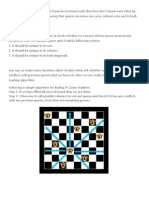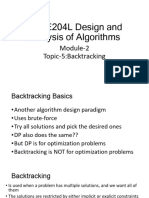0% found this document useful (0 votes)
21 views5 pages8 Queen Problem Copy - 2
The document discusses the 8 queens problem, a classic chess challenge of placing 8 queens on an 8x8 board without them attacking each other. It explores the problem's formulation, significance in algorithm studies, and presents a backtracking algorithm implementation in Java. The paper also highlights the computational complexity and number of solutions for different board sizes.
Uploaded by
Vandana VijayanCopyright
© © All Rights Reserved
We take content rights seriously. If you suspect this is your content, claim it here.
Available Formats
Download as PDF, TXT or read online on Scribd
0% found this document useful (0 votes)
21 views5 pages8 Queen Problem Copy - 2
The document discusses the 8 queens problem, a classic chess challenge of placing 8 queens on an 8x8 board without them attacking each other. It explores the problem's formulation, significance in algorithm studies, and presents a backtracking algorithm implementation in Java. The paper also highlights the computational complexity and number of solutions for different board sizes.
Uploaded by
Vandana VijayanCopyright
© © All Rights Reserved
We take content rights seriously. If you suspect this is your content, claim it here.
Available Formats
Download as PDF, TXT or read online on Scribd
/ 5






























































































